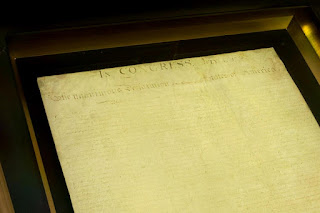September 26, 2006
We are up early today as we have a lot to see in Williamsburg. Williamsburg was the capital of the Virginia colony during Revolutionary times and the site of much history from that era. Shortly after the start of the Revolution, Virginia moved the capital inland to Richmond to hopefully provide more protection from sacking by the British Navy. The city of Williamsburg then went into decay. During the depression, the Rockefeller family donated money so that the entire town would be preserved for history. The site is now managed by a private non-profit foundation.
A ticket into Williamsburg is very expensive but is well worth it. They have reconstructed much of the town, but what makes it special is the very knowledgeable staff, all in period costumes, who pretend to be from Revolutionary times. We start in the Visitor’s Center and watch an old movie starring a young Jack Lord (of Hawaii 5-0 fame) as a Williamsburg resident and Virginia legislator trying to make up his mind if he is going to vote for Independence or not. It is a very good film and sets the stage for touring Williamsburg. From there we make the fifteen-minute walk into Colonial Williamsburg. We first join a tour of the Governor’s Palace. The mansion is nice but the guide brings it alive and relevant. It started off as the home and office of the British-appointed governor. After the last British governor fled at the beginning of the Revolution, the home was occupied by Patrick Henry (Give me Liberty or give me death) and Thomas Jefferson, the first and second governors of the new Virginia Independent State.
From there we walk down the main street visiting the Church and some of the craft shops. At the far end of town we tour the Capitol Building. The guide for the capitol is awesome. The colonial government mimicked the British Parliament exactly with a House of Lords and a House of Commoners because most colonists considered themselves full British citizens. It wasn’t until England began treating the colonies as conquered states that talk of Independence arose.
From there we stop at one of the taverns for an outdoor lunch. During lunch, Aimee gasps with terror as she sees a mouse dart under the ivy-covered lawn. Later we find that the man who runs all the restaurants was eating nearby and comp’d our meal. That pet mouse Aimee carries around finally pays off!
After lunch we tour the gaol (jail). Crime was relatively low as the sentence for any significant crime, including theft over 25 shillings, was hanging.
At 2:30 a dozen period-costumed actors migrate to one end of the town and recreate the day that British authority dissolved the Virginia legislature and set Virginia on the road to declaring independence. It is amusing and well acted but Aimee and I find it slow and somewhat repetitive as we have heard the story now a few times from the movie and the tour guides. We instead walk back thru the town touring more of the buildings. I especially like the gunsmith and the armory.
Beyond the west end of the town sits the College of William and Mary. It is the second oldest college in America (after Harvard) and was here before the town of Williamsburg. We tour the oldest building, which has some historical exhibits and restored rooms from its early days. Three of our presidents including Jefferson attended the school. The school gets its name from the English king at the time of charter, William of Orange and his queen Mary.
 By now our feet are sore and the park is closing so we head back. We haven’t seen everything but probably enough not to warrant a second day. Besides, Aimee and I got falsely accused of treason today and spend some time in the stocks. We don’t want to give the town a chance to reconsider our innocence.
By now our feet are sore and the park is closing so we head back. We haven’t seen everything but probably enough not to warrant a second day. Besides, Aimee and I got falsely accused of treason today and spend some time in the stocks. We don’t want to give the town a chance to reconsider our innocence.







.jpg)









































